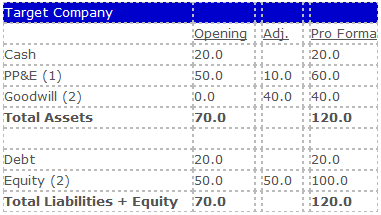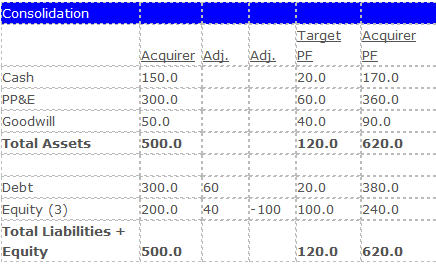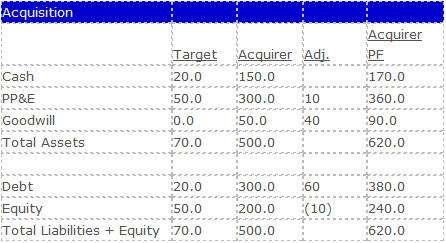 What is Deal Accounting?
What is Deal Accounting?
Acquisition accounting has always been a challenge for analysts and associates. I think it’s partly because the presentation of purchase accounting (the method prescribed under US GAAP and IFRS for handling acquisitions) in financial models conflates several accounting adjustments, so when newbie modelers are thrown into the thick of it, it becomes challenging to really understand all the moving parts.
Similar to the previous article where we covered LBO analysis, the goal of this article is to provide a clear, step-by-step explanation of the basics of acquisition accounting in the simplest way possible. If you understand this, all the complexities of acquisition accounting become much easier to grasp. As with most things finance, really understanding the basic building blocks is hugely important for mastery of more complex topics.
For a deeper dive into M&A modeling, enroll in our Premium Package or attend a financial modeling boot camp.
Deal Accounting: 2-Step Process Example
Bigco wants to buy Littleco, which has a book value (assets, net of liabilities) of $50 million. Bigco is willing to pay $100 million.
Why would an acquirer be willing to pay $100 million for a company whose balance sheet tells us it’s only worth $50 million? Good question – maybe because the balance sheet carrying values of the assets don’t really reflect their true value; maybe the acquirer company is overpaying; or maybe it’s something else entirely. Either way, we’ll discuss that in a little while, but in the meantime, let’s get back to the task at hand.
Step 1: Pushdown Accounting (Purchase Price Allocation)
In the context of an acquisition, the target company’s assets and liabilities are written up to reflect the purchase price. In other words, since Bigco is willing to buy Littleco for $100 million, in FASB’s eyes, that’s the new book value of Littleco. Now the question becomes how do we allocate this purchase price to the assets and liabilities of Littleco appropriately? The example below will illustrate:
Fact Pattern:
- Bigco buys Littleco for $100 million
- Fair market value of Littleco PP&E is $60 million
- Bigco finances the acquisition by giving Littleco shareholders $40 million worth of Bigco stock and $60 million in cash, which it raises by borrowing.

- In an acquisition, assets and liabilities can be marked up (or down) to reflect their fair market value (FMV).
- In an acquisition, the purchase price becomes the target co’s new equity. The excess of the purchase price over the FMV of the equity (assets – liabilities is captured as an asset called goodwill.
Under purchase accounting, the purchase price is first allocated to the book values of the assets, net of liabilities. In this case, we can allocate $50 million of the $100 million purchase price to these book values, but there is a remaining excess of $50 million that needs to be allocated. The next step is to allocate the excess purchase price to the FMV of any assets / liabilities. In this case, the only asset that has a FMV different from its book value is PP&E ($60 vs. $50 million), so we can allocate another $10 million to PP&E.
At this point we have allocated $60 million of the $100 million purchase price and we’re stuck: Under accounting rules we cannot write up assets above their FMV, but we know that our balance sheet somehow has to reflect a $100 million book value (the purchase price). The accounting answer to this is goodwill. Goodwill is a truly intangible asset that captures the excess of the purchase price over the FMV of a company’s net assets. Another way to think of it is FASB saying to Bigco “we don’t know why you’d pay $100 million for this company, but you must have a reason for it – you can capture that reason in an intangible asset called goodwill.” So that’s it – we have “pushed down” the purchase price onto the target, and we are ready for the next step: combining the adjusted target balance sheet with the acquirer’s:
Step 2: Financial Statement Consolidation (Post-Deal)
Consolidation Recall that Bigco finances the acquisition by giving Littleco shareholders $40 million worth of Bigco stock and $60 million in cash. That’s what it will cost to buy out Littleco shareholders:

(3) Acquirer can finance the acquisition with debt, cash, or a mixture. Either way, the target company equity is eliminated. The key takeaway here is to understand that Littleco equity is being eliminated – and that some Littleco shareholders have become Bigco shareholders (the $40 million in new equity issued by Bigco to Littleco), while some shareholders received cash in exchange for tendering their shares ($60 million which Bigco raised by borrowing from a bank).
Putting this all together, you would likely see something that looks like this in a model:

Deal Accounting Tutorial Conclusion
I hope this helps understand the basics of M&A accounting. There are many complexities to M&A accounting that we did not address here – treatment of deferred tax assets, creation of deferred tax liabilities, negative goodwill, capitalization of certain deal-related expenses, etc. Those are the issues we spend a great deal of time working through in our Self Study Program and live seminars, which I encourage you to participate in if you haven’t already.

Everything You Need To Master Financial Modeling
Enroll in The Premium Package: Learn Financial Statement Modeling, DCF, M&A, LBO and Comps. The same training program used at top investment banks.
Enroll Today





Thanks a lot for exemplying such a topic in this simple for me.
Thank you for sharing! Hope you could advise this: The franchisor will buy out their franchisee. They will offset receivables against purchase prices. They will succeed only assets(cash, inventory, fixed assets and deposits), and they will not succeed liabilities. Franchisees do not maintain book value for each outlet, and they… Read more »
Thanks a lot ! you’re amazing !!
Hi Matan, Thanks for your article. I just want to check with you what will be the accounting treatment for this transaction. Our company will buy another company worth 780K. It has office unit worth 760K and remaining loan from the bank of 540K. The difference 240K is drawing from… Read more »